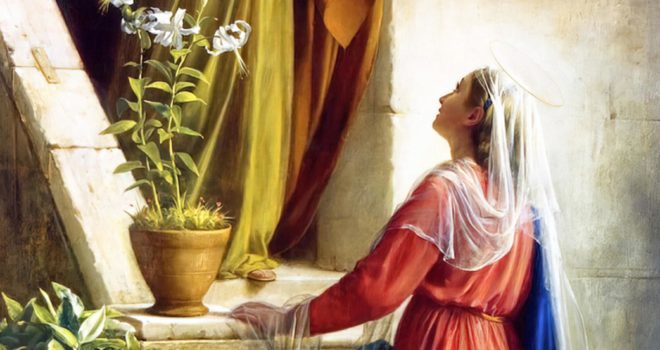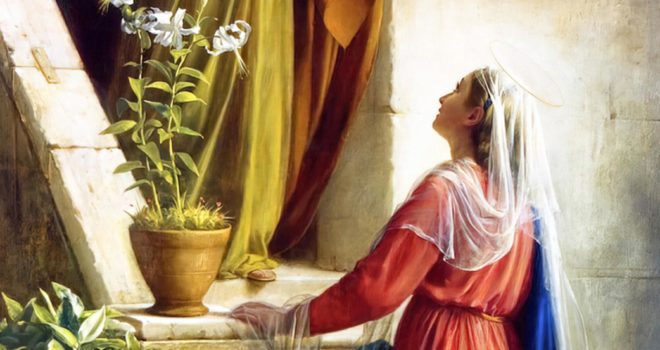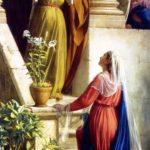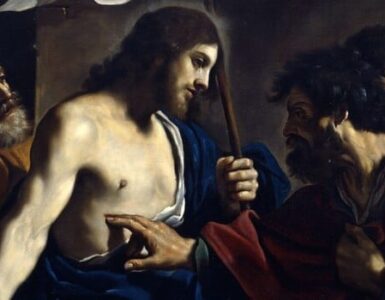Viewing and pondering sacred art offers the faithful a great way to prepare for the birth of Our Blessed Lord at Christmas. This series of articles will highlight several pieces of art related to the Gospel readings of this year’s lectionary cycle, as well as two pieces related to the week leading to Christmas. Each of these pieces of art allows us to reflect deeply on God’s plan for our lives, and to be prepared for the joyful celebration of Our Lord’s Nativity.
In the week leading to Christmas, we read the Gospel passage that tells us what happened after Mary made her fiat at the Annunciation. We hear that she “set out…in haste” from Nazareth. Her destination was the hill country of Judea, near Jerusalem, specifically the home of her kinswoman. At the Annunciation, the archangel Gabriel confirmed that he was God’s messenger by informing Mary of her elder cousin’s miraculous pregnancy. In this Gospel passage, we hear of the excitement between these two women. Elisabeth exclaims that Mary is “Most blessed…among women,” and that the fruit of her womb is blessed. Finally, Elisabeth proclaims to Mary, “Blessed are you who believed that what was spoken to you by the Lord would be fulfilled” (Luke 1:39-45). This is a joyful encounter, a moment when both women know that God has finally answered their prayers and fulfilled His plan.
In 1866, Carl Heinrich Bloch painted The Meeting of Mary and Elisabeth. Bloch’s rendition of this biblical event is simple, but it captures Elisabeth’s excitement and Mary’s awe at what the Lord has done. This is a wonderful piece of art that gives us deeper insights into the Advent seasons, and provides an appropriate final stop during our pilgrimage to the Nativity.
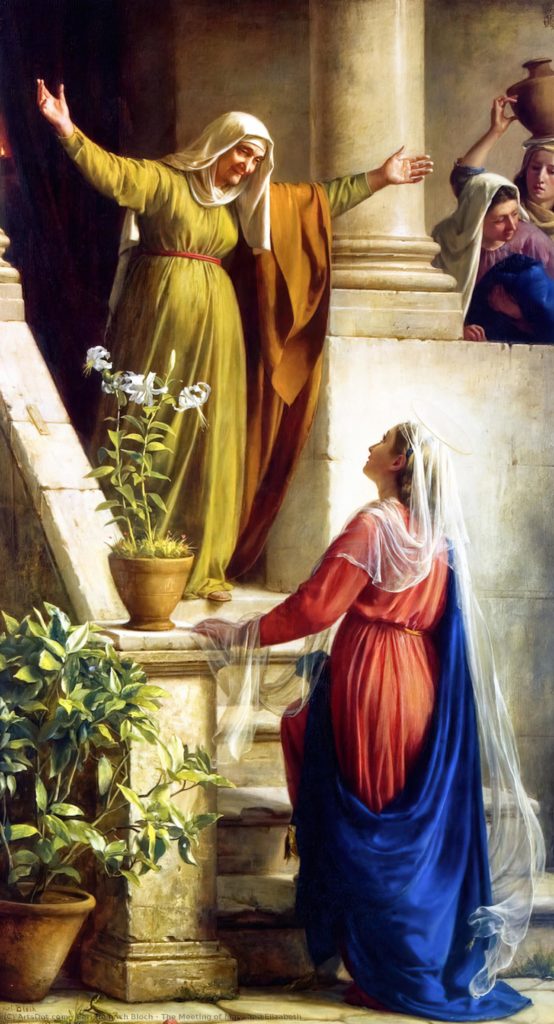
In the foreground of the painting, Mary stands at the bottom of the steps at Zechariah and Elisabeth’s home. She wears the same blue garment that distinguishes her in so many pieces of sacred art. Still, more interesting than the blue mantle is the sheer veil that flows around her whole body. Bloch probably used this symbolic detail to highlight Mary’s role as the Ark of the New Covenant. The veil is intended to shield this New Holy of Holies from the view of just any person. In this scene, only Elisabeth can see through the proverbial veil. During Advent, each of us can look to the Blessed Mother as the one who bears God to us. Specifically, we can ask her to pull back the veil that is over our eyes so that we can meet the Lord more fully.
While she stands at the bottom step, Mary gazes up at Elisabeth with a look that seems to express amazement at what has happened in both their lives. Even though she was sinless, Mary still would not have had the fullest understanding of God’s exact plans. She would have needed that understanding to come in stages, sometimes through miracles. At this moment, she is in awe of the way God has worked to fulfill His plan. This can be our disposition during Advent, too. We recognize that we don’t fully comprehend God’s plan and His ways. We wait for fulfillment and we stand in wonder as we recognize His miraculous movements.
It seems that Elisabeth, at the top of the steps, is the focal point of this painting. She bears a joyful look on her elderly face, and she stretches her arms wide to greet Mary. This is the moment when she “cried out in a loud voice and said, ‘Most blessed are you among women….’” In her own joy and amazement, Elisabeth queries, “And how does this happen to me, that the mother of my Lord should come to me?” During this blessed season, we want to capture St. Elisabeth’s wonder and awe. Even though I am unworthy, I am happy and blessed that Mary sees fit to bring Jesus to me in a similar way that she brought Him to Elisabeth.
Bloch’s rendition also draws a bit of attention to Elisabeth’s pregnancy. Immediately, we think of the infant in her womb, John the Baptist, who “leaped for joy” at Mary’s greeting. At this moment, our thoughts move forward in time to the Baptist’s mission of pointing to the Messiah. In Advent, we need to mirror John’s joy and zeal, because Our Blessed Lord is nigh and He is going to win salvation for us! Nearly everyone in this scene, even the one we cannot see, is wrapped in joy!
There are two other women, however, on the porch of the house who are not expressing the same joy. These women seem distracted by chores or other people out of the scene. While we don’t know exactly what occupies these women, we can recognize that there are many things that can take our attention off of God’s plan and His work. During Advent, we can prayerfully ask the Lord to help us focus in the midst of potential distractions and find true joy.
Between Mary and Elisabeth, in the visual center of the painting, stands a pot with flowers that seem to be lilies. Lilies, of course, represent rebirth, purity, virtue, and innocence. These two women provide us with a deeper appreciation for each of these qualities. They are especially models of fidelity, even in the midst of uncertainty. This detail ought to remind us that Advent is a blessed time in which each of us can ask for a renaissance by the Lord’s grace, a rebirth facilitated by growing in virtues of faith and purity.
Bloch’s painting of this biblical event makes a fitting culmination of our Advent pilgrimage with art. We have seen how Advent prepares us to avoid falling into the patterns of “the days of Noah.” We have heard the call to repentance made by the Voice Crying Out in the Desert. We have empathized with John in his despair of not seeing the completion of God’s plan. Finally, we can enter into the joy and wonder of these women at the ways God unexpectedly, miraculously fulfills His plan. These final dispositions are ultimately what God wants us to have during Advent and all year long. Here’s hoping we all experience such joy and wonder in the last days of Advent, during the Christmas season, and beyond.
✠
The Meeting of Mary and Elisabeth, by Carl Bloch, is on display at the Brigham Young University Museum of Art in Provo, Utah. Reproductions are in the public domain.


